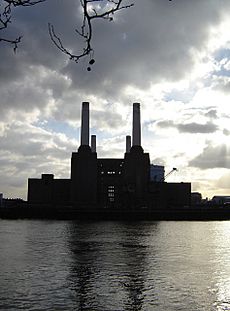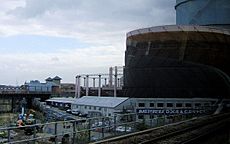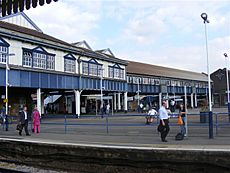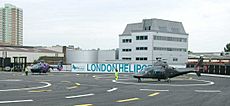Battersea facts for kids
Quick facts for kids Battersea |
|
|---|---|
 Peace Pagoda, Battersea Park |
|
| Population | 73,345 (2011 census) |
| OS grid reference | TQ2776 |
| London borough | |
| Ceremonial county | Greater London |
| Region | |
| Country | England |
| Sovereign state | United Kingdom |
| Post town | LONDON |
| Postcode district | SW8, SW11 |
| Dialling code | 020 |
| Police | Metropolitan |
| Fire | London |
| Ambulance | London |
| EU Parliament | London |
| UK Parliament |
|
| London Assembly |
|
Battersea is a large area in southwest London, England. It is part of the London Borough of Wandsworth. Battersea is about 3.5 miles (5.6 km) southwest of Charing Cross and stretches along the south bank of the Thames Tideway. It is home to the 200-acre (0.8 km²) Battersea Park.
Contents
A Look Back in Time
Long ago, Battersea was part of Surrey. It grew around a church on an island where a small river called the Falconbrook met the River Thames. The name Battersea comes from old words meaning "Badric's Island." Over time, people drained marshy land to create more space.
The old village center is still marked by St. Mary's Church. Churches have stood on this spot since the 800s! The current church was finished in 1777. Famous people like artist William Blake got married there.
In the old Domesday Book, Battersea was called Patricesy. It was owned by Westminster Abbey. It had farms, mills, meadows, and woodlands.
From Farms to Factories
Before the Industrial Revolution, Battersea was mostly farmland. It grew food like lavender (on a place now called Lavender Hill) and asparagus for London. People also raised pigs here.
Later, industries started to grow along the River Thames. This was because the river was great for transport and for powering machines. Many factories opened, making things like candles and chemicals. One very important factory was the Morgan Crucible Company, which is still around today.
In 1929, work began on the famous Battersea Power Station. It was finished in 1939. For many years, Battersea was a busy industrial area. But in the 1970s, many factories closed. Now, old factory sites have been replaced by modern apartment buildings.
The Railway Age
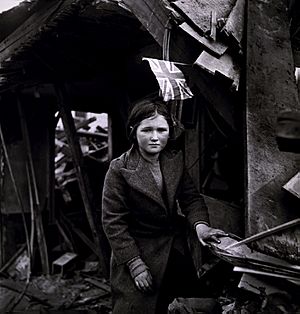
Railways changed Battersea a lot. The first railway line came through in 1838. Soon, many other lines were built. In 1863, a big train station was built. It was named 'Clapham Junction', even though it's in Battersea!
This station became very busy. It helped Battersea grow from 6,000 people in 1840 to 168,000 by 1910. Most of the farmland was built over with houses and railway yards.
The railway station also led to new buildings like the town hall, library, and police station along Lavender Hill. A large department store called Arding and Hobbs opened in 1885. The area around the station became a major shopping spot.
Housing Estates
Battersea has many public housing estates built in the mid-1900s. Most of these are north of the main railway lines. Some of the biggest estates include the Winstanley Estate, the Surrey Lane Estate, and the Doddington and Rollo Estate.
How Battersea Was Governed
For a long time, Battersea was managed by the local church group, called a Vestry. This group helped with things like caring for the poor and managing drainage.
In 1899, Battersea became the Metropolitan Borough of Battersea. This meant it had its own local government. The old Battersea Town Hall, opened in 1893, is now the Battersea Arts Centre.
In 1965, the Borough of Battersea joined with the Metropolitan Borough of Wandsworth to form the larger London Borough of Wandsworth.
Battersea has a history of being a place for new ideas in politics. In 1913, John Archer became the first black mayor in London here. In 1922, Shapurji Saklatvala, a member of the Communist Party of Great Britain, became a Member of Parliament for Battersea.
Today, Battersea is divided into five local areas within Wandsworth. The current Member of Parliament for Battersea is Marsha de Cordova.
Geography of Battersea
Battersea is on the south bank of the River Thames. Its northern edge follows the river. To the east is Lambeth, to the south are Balham and Clapham, and to the west is Wandsworth.
Nearby Places
 |
Fulham | Chelsea | Pimlico |  |
| Wandsworth | Nine Elms and Stockwell | |||
| Wandsworth and Balham | Balham and Clapham | Clapham |
People in Battersea
In 2011, Battersea had a population of 73,345 people.
Famous Landmarks
Here are some well-known places in Battersea:
- New Covent Garden Market: A huge market where fruits and vegetables are sold wholesale.
- Battersea Power Station: A famous building that used to generate electricity. It was even on a Pink Floyd album cover! Now, it's a place for shops and entertainment. It has its own Underground station.
- Battersea Dogs and Cats Home: A very famous rescue center for stray dogs and cats. It started in 1860.
- Battersea Park: A large green park with a zoo and the London Peace Pagoda.
- Shaftesbury Park Estate: An area with over a thousand old Victorian houses that have kept their original look.
- Battersea Arts Centre: Located in the old Battersea Town Hall.
- Northcote Road: A busy shopping street with its own market.
- Clapham Junction railway station: One of the busiest train stations in the UK, even though it's named after a different area.
- Arding & Hobbs building: A large, historic department store building.
- St Mary's Church, Battersea: An old church where Benedict Arnold is buried.
- Sir Walter St John's School: A school founded in 1700, now called Thomas's day school.
- The London Heliport: London's busiest place for helicopters to land and take off.
Getting Around Battersea
Battersea has good transport links, including trains, the Underground, buses, and cycling routes.
Trains
Battersea has three main train stations: Battersea Park, Clapham Junction, and Queenstown Road (Battersea).
Battersea Park Station
Battersea Park station has trains that go to London Victoria and places like Clapham Junction, Balham, and Gatwick Airport.
Clapham Junction Station
Clapham Junction is a very busy station. You can catch trains here to many parts of London and other cities in the South of England.
- London Overground trains go to places like Stratford and Dalston.
- Southern trains go to London Victoria, Brighton, and Gatwick Airport.
- South Western Railway trains go to London Waterloo and places like Wimbledon and Reading.
Clapham Junction is known as Europe's busiest railway station by the number of trains passing through.
Queenstown Road (Battersea) Station
Queenstown Road station has trains that go to London Waterloo and places like Richmond and Windsor & Eton.
London Underground
Battersea is now connected to the London Underground (Tube) network! The Northern Line was extended, and the Battersea Power Station tube station opened in 2021.
Buses
Many London Bus routes serve Battersea during the day and some even run all night.
Cycling
There are also special cycling routes in Battersea, like Cycle Superhighway 8, which helps cyclists get around safely.
Battersea in Books and Music
Battersea has been featured in many books and songs.
- Books by Michael de Larrabeiti show what working-class Battersea was like in the 1940s and 1950s.
- Penelope Fitzgerald's novel Offshore is also set in Battersea.
- Nell Dunn's novel Up the Junction describes life in the industrial areas of Battersea near Clapham Junction.
- Musicians like Morrissey and Babyshambles have mentioned Battersea in their songs.
Famous People from Battersea
Many well-known people have lived or live in Battersea, including:
- Adele – singer-songwriter
- Ronnie Biggs – a criminal involved in the Great Train Robbery
- Johnny Briggs – actor from Coronation Street
- Brian Cox – physicist and TV presenter
- Nell Dunn – playwright
- Bob Geldof – singer and songwriter
- Graham Greene – writer
- Harry Hill – comedian
- Katie Leung – actress (Cho Chang in Harry Potter)
- Dannii Minogue – musician
- Gordon Ramsay – chef
- J.K. Rowling – author
- Ed Sheeran – musician
- Timothy Spall – actor
- William Wilberforce – a famous campaigner against the slave trade
Images for kids
See also
 In Spanish: Battersea para niños
In Spanish: Battersea para niños



